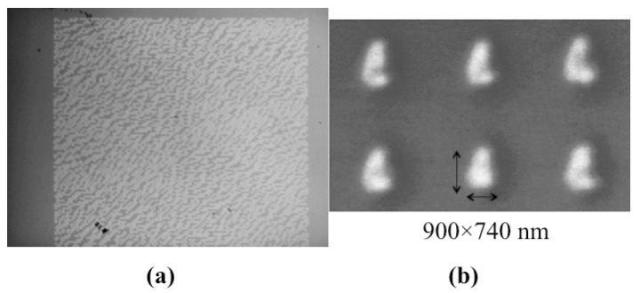Apr 20 2016
Two-dimensional images are shown for each eye with standard 3D displays, like glass-free autostereoscopic displays and stereo displays with glasses. These pseudo-3D images result in users experiencing incongruity and eyestrain. A holographic display forms a precise copy of the wave front of scattered light discharged from an object, and because of this a 3D display that is realistic is expected. Realistic 3D images can be reconstructed by holographic displays, preventing the requirement for special glasses.
 This is an image composed of nano-magnetic pixels. (a) A 256×256-pixel 1 micrometer-pitch image obtained via polarization microscopy and (b) a 3×2-pixel 2.5-micrometer-pitch image obtained via magnetic force microscopy. (Copyright (C) Toyohashi University of Technology. All Rights Reserved).
This is an image composed of nano-magnetic pixels. (a) A 256×256-pixel 1 micrometer-pitch image obtained via polarization microscopy and (b) a 3×2-pixel 2.5-micrometer-pitch image obtained via magnetic force microscopy. (Copyright (C) Toyohashi University of Technology. All Rights Reserved).
Producing holographic displays is considered a difficult task as nano-sized pixels are needed to reconstruct 3D images containing a wide viewing-angle. A pixel pitch of 10-100 µm and a viewing angle of <3° are present in standard holographic displays.
Recently, researchers at Toyohashi Tech constructed wide-viewing 3D holographic displays with nano-magnetic pixels.
These displays are monitored by thermomagnetic recordings, and wide viewing-angles are obtained by using in-house-developed magneto-optic spatial light modulators (MOSLMs) containing nano-sized pixels.
The advantages of this approach are that the focused spot of a laser defines the pixel size, the MOSLM does not require special current or voltage drivelines, and the switching speed is about 10nsec/pixel that is enough for real-time display. Therefore, the MOSLM can represent 3D movie because display media is a rewritable magnetic material. In addition, the magnetic hologram is stored for magnetic materials semi permanently. The viewing angle depends on pixel pitch size. In this study, we adjusted to the pixel pitch size of 1μm after obtaining the pixel size of 1µm.
Associate Professor Takagi, Toyohashi Tech
This establishes the fact that a 3D display containing 1 µm-pitch pixels is capable of displaying holographic images at viewing angles more than 30°. This display presents an interesting option to view 3D objects without special glasses and with a smooth motion parallax.